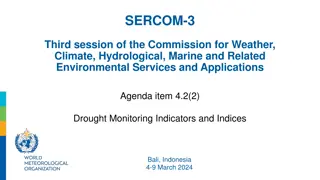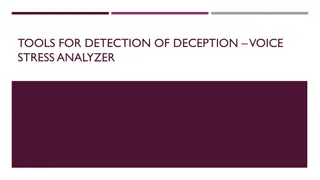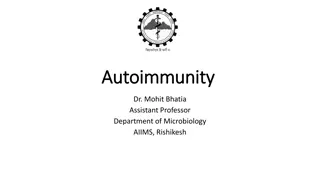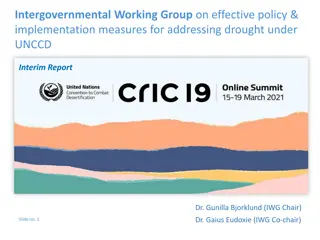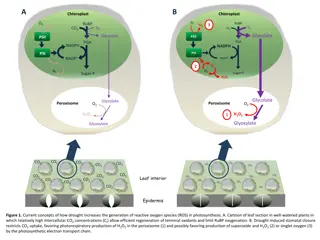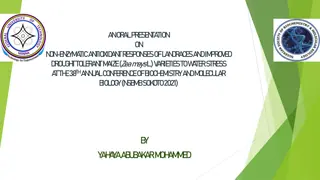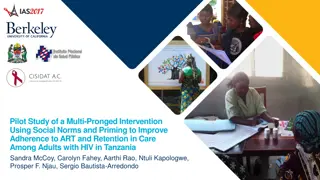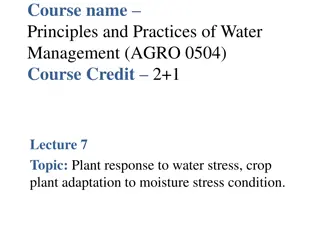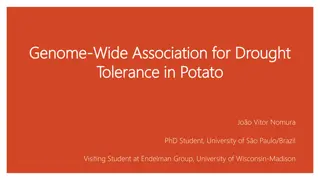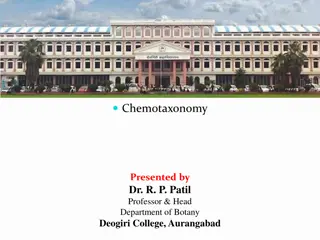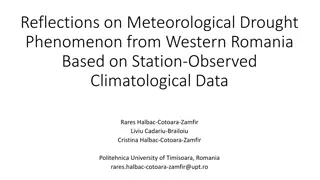Understanding Chemical Priming for Drought Stress Tolerance in Plants
Major agricultural industries struggle with abiotic stresses like drought, which can lead to crop losses. Nutrient limitations and cellular damage further compound the challenges plants face under water-limited conditions. Despite efforts in plant breeding, improving germplasm for drought tolerance remains difficult due to the intricate nature of plant responses to stress. Alternative solutions are needed beyond traditional breeding practices to address these issues globally.
Download Presentation

Please find below an Image/Link to download the presentation.
The content on the website is provided AS IS for your information and personal use only. It may not be sold, licensed, or shared on other websites without obtaining consent from the author. Download presentation by click this link. If you encounter any issues during the download, it is possible that the publisher has removed the file from their server.
E N D
Presentation Transcript
Chemical Priming-Induced Drought Stress Tolerance in Plants Prepared by Prof. Dr. Hussein K. Zair
Major agricultural industries have few technological defenses against crop loss due to abiotic stresses, particularly drought stress. Drought stress is a complex stress since it often coincides with high light stress and high temperature stress to plant canopies.
Nutrient limitation is also commonly encountered by plants under water limited conditions. These secondary stresses occur because major physiological processes such as photosynthesis, transpiration, and respiration may become limited during drought conditions.
In addition to drought having an effect on whole- plant responses, cellular level processes are also severely limited due to lack of adequate turgor pressure and other cellular damage. Cell division, elongation, and differentiation are the major processes that determine plant growth and productivity..
These cellular processes are highly drought sensitive. Due to the complex effects of drought stress on multiple plant processes and the quantitative nature of genes involved in plant tolerance, plant breeding aimed to improve plant germplasm for drought tolerance is difficult.
Breeding practices, whether classical or via biotechnological methods, are known to be relatively slow in producing new germplasm on the market. Additionally, new germplasm available on the market is not the only answer to the problem of abiotic stresses in agriculture..
Many areas worldwide do not often have access to new varieties, may not have the funds for such varieties, may have restrictions on genetically modified materials, and certain new germplasm may not function as predicted in all climates.
Additionally, regardless of location, farmers or crop managers need quicker strategies or solutions for existing perennial crop species. For all of these reasons, plant priming technologies aimed to improve drought tolerance with various exogenous compounds is of extreme importance to aid in reducing crop losses and allow for agriculture to support growing demands from the human population.
Plant priming in this presentation is defined as the application of any exogenous compound, microorganism, or abiotic stress in order to activate or enhance a plant s own natural defenses in order for the plant to be better prepared for a future stress. In scientific literature, compounds that have a direct effect on acquired systemic immunity are most commonly referred to as priming agents.
This has been termed defense priming (Conrath 2011). But for purposes of this chapter the term priming will be used more broadly in order to expand the relevance of the term priming to many practices that aim to promote drought tolerance.
Using a broad definition of priming in this chapter allows for a discussion of many types of priming practices that may not necessarily cause the same physiological as does defense priming. Thus, it allows for discussion of many methods used for seed, foliar, and root priming of plants for drought tolerance.
For plant priming for drought tolerance to be an effective solution to promote agricultural yields, more widespread information is needed on how these compounds are effective, what plants they are effective on, under what conditions are the com- pounds effective, what is the duration of the effectiveness, and if applicable, what trade or brand names they are available under.
What specific physiological mechanism each priming compound or method is targeting and how that affects whole plant functioning needs to be elucidated and disseminated. In other words, many priming technologies still require further research in order to move from the realm of basic science to an effective, widespread applied agricultural technology.
1- Seed Priming Seed priming is a very common practice in the agricultural seed industry. The seed industry has various types of priming technologies available including chemopriming, hydropriming, osmopriming, solid matrix priming, biopriming, thermopriming, and halopriming (Paparella et al. 2015; Mondal and Bose 2014)..
The goals of the seed priming and treatment type used can vary based on the end use of the seed stock. Commercial seed lots are most commonly primed for enhanced germination potential. Other establishments such as seed banks may prime seeds to supplement preservation practices or prolong dormancy under less than optimal conditions.
The goals of seed priming vary but all are targeting physiological processes that occur prior to seed germination. These processes include seed defense mechanisms that preserve seed health for germination such as DNA repair and reduction of oxidative stress (Paparella et al. 2015). Seed priming methods include chemical, physical, and biotic treatments. Generally, priming seeds to promote crop performance by enhanced tolerance of abiotic and biotic stresses is less common than other seed priming practices.
However, since adverse environmental growing conditions and water resource limitations may become more and more problematic in the future, priming of seeds to promote crop tolerance of abiotic stresses is of growing interest in agriculture (Jisha et al. 2013). Chemical priming of seeds for abiotic stress tolerance has been suggested to cause mild to moderate stress on seeds to allow for better preparedness for response to future stresses (Gallardo et al. 2002).
2- Foliar priming Exogenous application of various compounds to above ground plants parts is a common practice in plant research and in agricultural practice to enhance the performance of a given crop. Foliar spray priming methods may be adopted if seed or root incorporation methods are not feasible, based on the intended result of the priming practice, or if the compound requires leaf or stem exposure for the compound to be taken up by the plant.
Perennial crop plants may not benefit as much long-term from seed priming practices compared to annual crop plants that may be re-seeded every year
Root zone based priming practices may be difficult to incorporate into already established perennial crops or no-till annual cropping systems. Additionally, both annual and perennial crops often demonstrate drought resistance strategies that are in contrary to good yield production, such as escape and avoidance mechanisms. For all of these reasons, foliar priming practices to improve both annual and perennial crop drought tolerance are of great importance to agriculture..
Foliar priming practices can be done at any stage of the plant life cycle. Some prim- ing compounds may have a degree of cell toxicity associated with them, so whether priming with a given compound should be performed on a mature plant compared to a seedling may vary among technologies
3- Root Priming Priming of the root zone can be effective for priming compounds that are not readily taken up by above-ground plant parts or are more naturally occurring or absorbed by plant roots. Some chemical compounds are also best to apply to the root zone as they stimulate microorganism associations with roots that promote abiotic stress tolerance. Various plant developmental stages are also targets for root priming prac- tices, from seedlings to mature plants.
Priming of the roots is also a common research practice as the plants can be under uniform exposure to the compound for optimal evaluation of the effects of the compound, such as in hydroponics, tissue culture, or in various potting media types. Many of the compounds discussed below have been evaluated by root priming techniques.
Physiological Targets of Chemical Priming
When a plant is in a primed state, it has a higher level of fitness or readiness to take on a given stress. The primed plants are typically able to respond more rapidly and more effectively for stress protection. The rapid response is largely triggered by efficient plant hormone and other stress signaling systems such as reactive oxygen species accumulation. All of the priming agents mentioned in the chapter have many physiological targets in common or that are unique to each compound.
Several of the priming agents largely have an effect on antioxidant responses. Some of the compounds are able to illicit systemic acquired resistance (SAR) and induced systemic resistance (ISR) pathways, which are highly targeted by several plant priming methods. Abscisic acid, ethylene, auxins, and other stress associated hormones may also be regulated by plant priming strategies.
SAR responses are primarily associated with pathogen infection, particularly biotrophic pathogens. When a biotrophic pathogen infects a plant, salicylic acid (SA) accumulation serves as a systemic signal to activate defense response genes in the whole plant. SA signaling stimulates the production of pathogenesis-related (PR) proteins, which inhibit pathogen development and spread (Van Loon and Van Strien 1999).
This increases plant tolerance of the primary infection and may reduce secondary pathogen attack (Beckers and Conrath 2007). Interestingly, some necrotrophic pathogens are thought to have the ability to use the SA pathway against the plant to promote disease development (Rahman et al. 2012). The increase in SA and subsequent changes in SAR-inducible genes has been termed a primed state of plants.
Relative to biotic pathogens, less is known about how drought stress affects SAR responses. Abscisic acid is a key regulator of drought tolerance and is the hormone that stimulates stomatal closure to restrict water loss. In Arabidopsis, abscisic acid (ABA) and SAR were shown to act antagonistically since ABA accumulation suppressed SAR responses and SAR suppressed ABA biosynthesis (Yasuda et al. 2008). This may explain in part why plants could be more susceptibile to pathogen attach while under drought stress.
A plants ability to maintain or accumulate SA or SAR responses while under drought stress are often associated with drought stress tolerance. SA, either applied exogenously or maintained endogenously, have been associated with improved drought tolerance (Larkindale and Huang 2004; Senaratna et al. 2000a, b; Horv th et al. 2007; Krishnan and Merewitz 2015)..
Conversely, SA application was also shown to decrease drought tolerance in corn (Zea mays; Nemeth et al. 2002). The differences could be related to species or be concentration dependent
Gibberellic acid (GA) may also be a factor in regulating SA pathways. GA biosynthesis promotes the degradation of proteins known as DELLA proteins in plants. Higher concentrations of DELLA proteins are known to increase the resistance of plants to various stressors by improving salicylic acid (SA) defense pathways (Alonso- Ram rez et al. 2009). If drought reduces GA concentration in plant tissues, this could regulate SAR responses.
More work in this area is needed to better understand SA accumulation, SA exposure, and SAR activity with abiotic stress tolerance in relationship to other plant hormones. A better understanding of these responses could lead to better use recommendations for priming agents and new priming agent chemistries.
Several chemical priming agents are known to be SAR activators. For instance, 2,6-dichloroisonicotinic acid (INA) and acibenzolar-S-methyl (BHT) are well- known SAR activators (Conrath 2009). Exogenous application of SA has also been shown to regulate SAR responses (Ryals et al. 1996).
Major Priming Compounds and Their Effects on Drought Tolerance
1- Inorganic Compounds Chemical applications of macronutrients, micronutrients, or supplemental nutri- ents is done in order to provide plants with nutrients that may become limited dur- ing drought stress, are in high demand during drought periods, or have stress protective properties. Each type of salt generally has specific functions in plants and
has been studied for protective effects specifically during drought stress either as a pre- or posttreatment during recovery. As there are too many nutrients required by plants to discuss all in depth here, a few select salts (K, Si, and Se) relevant to drought tolerance are discussed. The section will also discuss several other compounds used as priming agents
Cellular requirements for K are significantly elevated under drought stress due to the role of K in regulating stomatal aperture, osmotic relations, photosynthesis, and reactive oxygen species signaling (Cakmak 2005). Rice plants containing trans- genes for increased K absorption via K transporters have been shown to be more drought tolerant compared to non-transgenic plants (Song et al. 2014).
Addition of K by foliar or root based applications to plants prior to drought stress has been shown in many studies to improve drought tolerance via both drought avoidance and tolerance mechanisms. For instance, in two wheat varieties contrasting in drought tolerance, K supplementation to the roots played a major role in promoting antioxidant responses, photosynthesis, and overall biomass during drought (Wei et al. 2013).
Improvements in root biomass and depth by K supplementation can have significant impact on droujght survival. Foliar application post-drought stress of K improved stomatal opening and recovery of photosynthesis in kentucky blue- grass (Poa pratensis) during recovery from drought stress (Hu et al. 2013). In addi- tion to studies done on drought stress, sources of K such as potassium phosphite have been shown to induce defense responses against various pathogens (Araujo et al. 2015)..
Thus, in addition to K playing a role in well- characterized drought responses, K-induced drought tolerance could also be associated with induced responses of secondary metabolites and plant protective compounds. Such assump- tions need further research
2- Amino Acidss Several amino acids such as proline naturally accumulate to high concentration in plant tissues during abiotic stress periods. Shifts in metabolism towards proline may play a role in osmotic adjustment, ROS scavenging, maintain cellular pH and redox balance, and play a role in stress signaling (Hare and Cress 1991; Ashraf and Foolad 2007). Wheat plants expressing the key enzyme in proline biosynthesis, -pyrroline- 5-carboxylate synthetase (P5CS), exhibited enhanced drought tolerance when the gene was under the control of a drought stress-induced promoter.
The improvement in drought tolerance was attributed to prolines role in protecting against oxidative stress (Vendruscolo et al. 2007). Since many protective effects of proline were observed in plant tissues, researchers attempted to sitmulate such responses with exogenous application. Priming of plants with proline has been shown to protect plants from drought and other stresses.
Priming with proline has similar effects on plants as those that naturally occur due to proline accumulation in plant tissues. For instance, improved photosystem func- tioning and enhanced soluble sugars were shown to accumulate under drought stress following proline application in Arabidopsis (Moustakas et al. 2011). Similar results were found due to proline application to soybean (Glycine max) under salt stress conditions (Yan et al. 2000)..
Compared to other stresses such as salt, the effects of exogenous application of proline specifically on promoting drought stress tolerance is lacking for many plant species in the literature. Additional work in this area would be beneficial so that rates and frequency of use are determined for various crop species.
This is particularly true because cellular damage has been associated with too much proline accumulated in plant tissues (Vendruscolo et al. 2007) or applied exogenously (Hare et al. 2002). Therefore, proline should not be considered an inert osmoprotectant when used as a priming agent
3- Nonprotein Amino Acids Compounds known as nonprotein amino acids are those amino acids that are not directly used in translational processes resulting in protein synthesis. They are also known as nonproteinogenic or non-coded amino acids. Nonprotein amino acids can be incorporated into proteins posttranslationally but largely they are metabolic intermediates within biochemical pathways or are products of proteolysis (Bell 2003). Some commonly investigated nonprotein amino acids related to priming for drought tolerance in plants include glycine betaine (GB), - aminobutyric acid (GABA), -aminobutyric acid (BABA), and 5- aminolevulinic acid (ALA).
GB is an osmoprotectant that is readily taken up by plant leaves, transported, and remains stable in plant tissues (Ashraf and Foolad 2007). The positive effects asso- ciated with GB in plant tissues under stress periods have made GB an interesting candidate for use as a priming agent. In response to salinity stress, GB has been associated with protection of plants by osmotic adjustment, protection or stabilization of important photosynthetic enzymes such as RuBisCo, and may be a free radical scavenger.
Many successes have been demonstrated by priming with GB for drought stress, particularly in plants that are not naturally high GB producers such as rice (Oryza sativa), potato (Solanum tuberosum), soybean (Glycine max), and tomato (Lycopersicum esculentum) (Agboma et al. 1997; Wani et al. 2013). For instance, supplementation with a pretreatment of exogenous GB was shown to improve phys- iological responses including relative water content and biomass production during drought stress (Rezaei et al. 2012). In soybean, positive effects of glycine betaine were exhibited during drought, which lead to increased yield, photosynthetic activ- ity, nitrogen fixation, and leaf biomass (Agboma et al. 1997).


